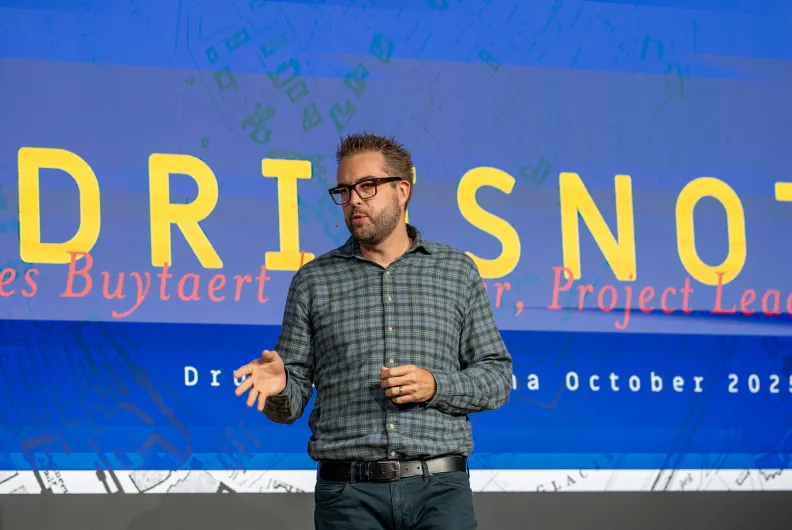Drupal’s Next Chapter: Key Highlights from the latest Driesnote in Vienna
“Whenever I look at these demo videos,
I often completely forget we’re looking at Drupal.
You know, it looks so different and so much better.”
— Dries Buytaert, creator of Drupal
Curious about where Drupal is headed and how it’s reshaping digital experiences for everyone, from developers to content creators? The answer comes alive in the keynote that Drupal founder Dries Buytaert delivers at every DrupalCon.
There’s always a thrill in the air before a Driesnote, that split-second when you try to guess what ideas, surprises, or bold visions will appear next. And yet, every single time, it goes beyond what anyone imagined. Drupal is achieving things that once seemed impossible — and it’s doing so at breathtaking speed.
Just like at DrupalCon Atlanta earlier this year, the Driesnote at DrupalCon Vienna 2025 dazzled. Here’s a wrap-up of the highlights, so you can stay on the pulse of what comes next for Drupal.
The key moments from Driesnote Vienna 2025
The map of the web is being redrawn and AI plays a key role
“We are entering an era where the landscape is being completely reimagined,” said Dries. Indeed, AI is changing everything. As he joked — or perhaps not — you can be super excited about AI in the morning and tired of it by evening.
Artificial intelligence both creates uncertainty, disrupting familiar workflows, and turns weaknesses into strengths, noted Dries. Big tech is betting on AI, and Drupal is ahead of the curve among CMSs when it comes to AI adoption.
Dries even compared AI to an approaching storm and said the best way to navigate it is to move towards it, just like bison instinctively do. That’s exactly what Drupal is doing: fully embracing AI and making the most of what it has to offer. In this post, you’ll see some of the stunning things AI can already do, and it’s just the beginning.
Dries announced that the Drupal AI Initiative raised a whopping $1M in funding in 5 months. Our team is happy to be part of this initiative and bring more AI innovation into Drupal.
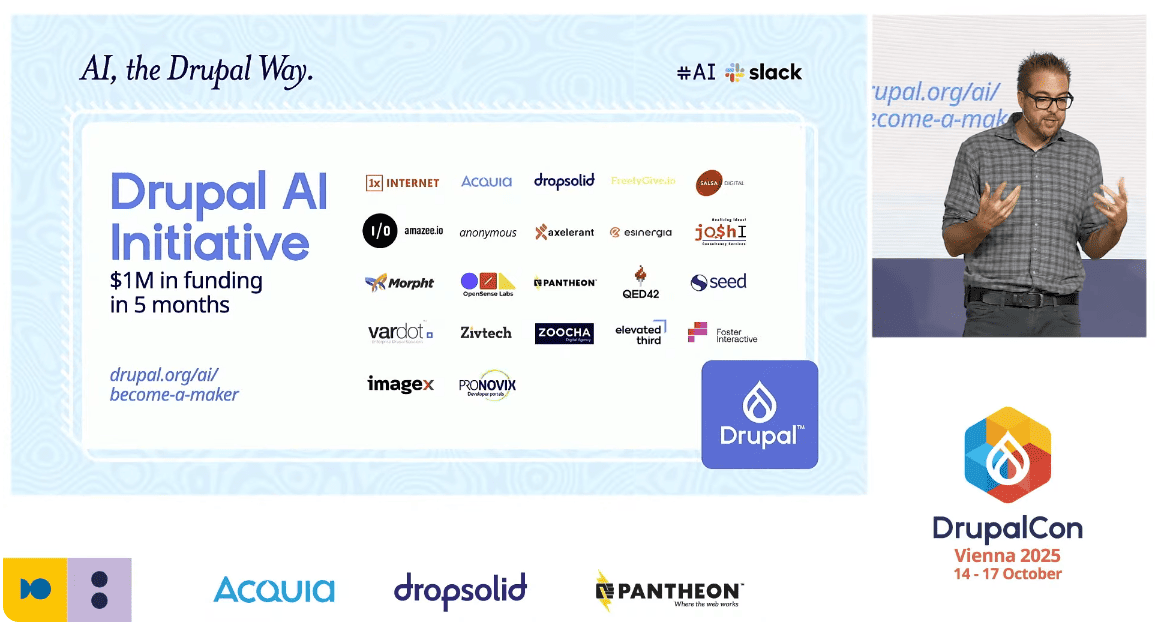
Sustained innovation: Drupal CMS is on the rise
The creators of Drupal CMS (known as the result of the Starshot Initiative) rallied around one clear goal, to grow Drupal by empowering site builders, marketers, and creators. The launch of the Drupal CMS has really sparked something in the community, noted Dries.
The number of organization credits has shown a big jump since the start of the Starshot Initiative. It’s not a one-time spike as this innovation is sustained, emphasized Dries. The best part is that this number has doubled since 2023.
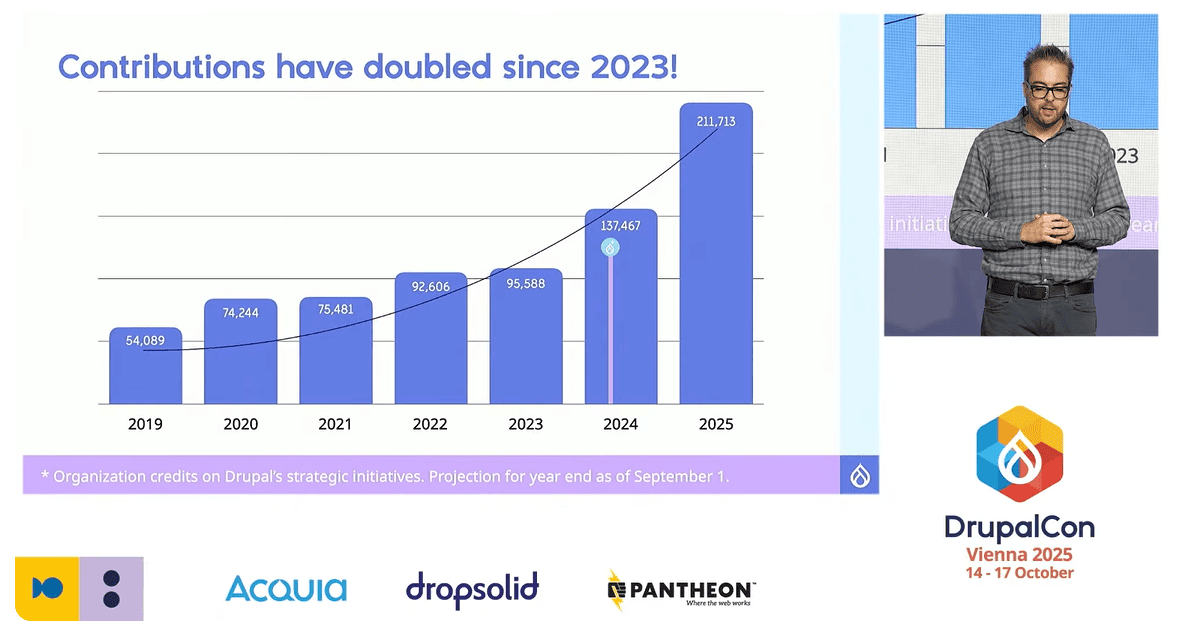
Site templates: launching websites in minutes
One of the things needed to grow Drupal adoption is to make it easy and fast to build sites. It began with Recipes, but at DrupalCon Atlanta, the concept of site templates was introduced. A template combines recipes, a theme, and sample content, everything you need to launch a website.
As you can see, templates are like one level up from recipes in these wonderful Legos. Drupal has actually always been like Lego, but now, it’s moving at full speed towards a whole new future where user-friendliness is ultimate and lots of things are pre-assembled.
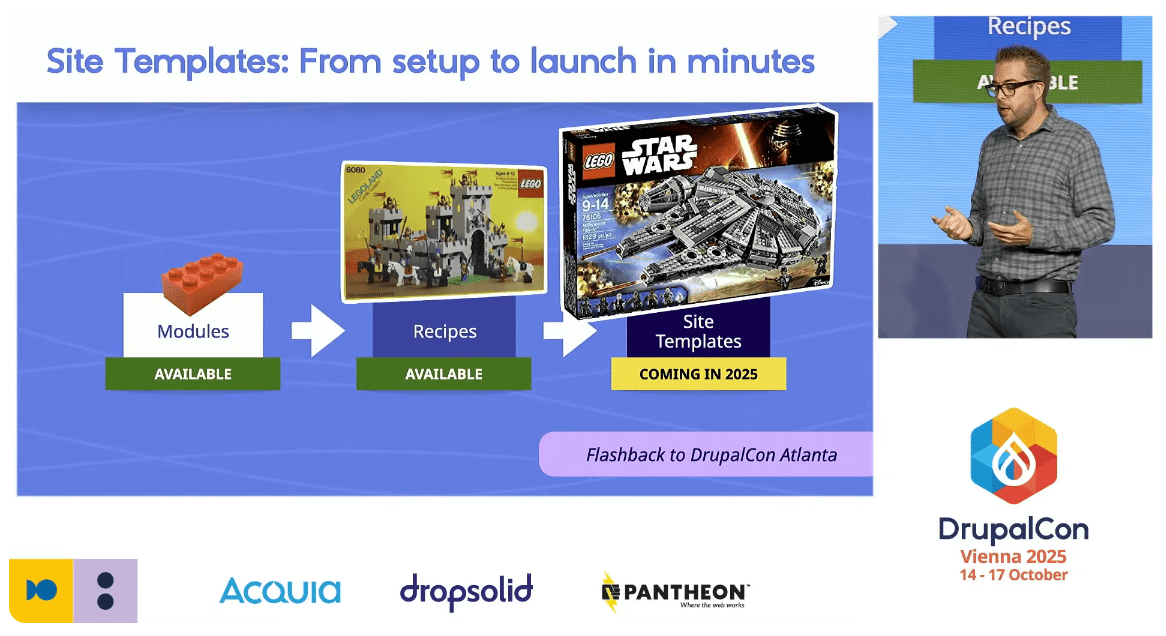
During the installation of the Drupal CMS 2.0, users will be offered to choose templates instead of recipes they were offered in Drupal CMS 1.0.
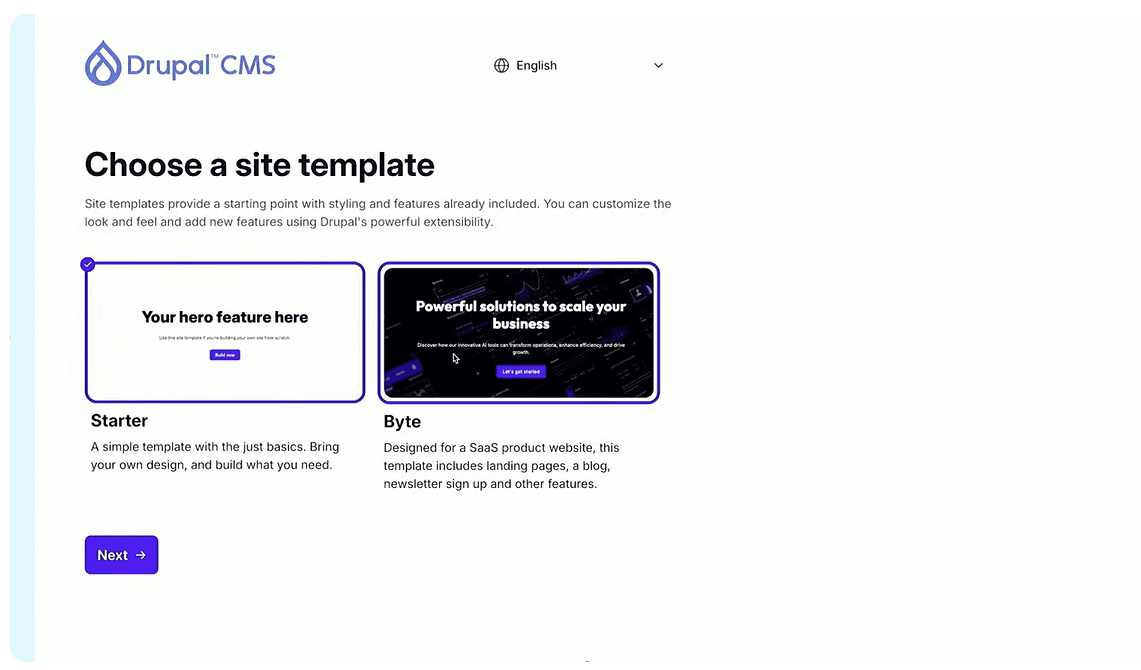
We saw the new Byte template at a closer look at Driesnote. It’s perfect for business-to-business websites for expense management software. This template uses Mercury, a newly-built theme and design system to compose pages with such sections as software features, price offerings, resources & support, a list of recent blog articles, and a contact form.

The next step is to build hundreds of new site templates for various use cases, announced Dries.
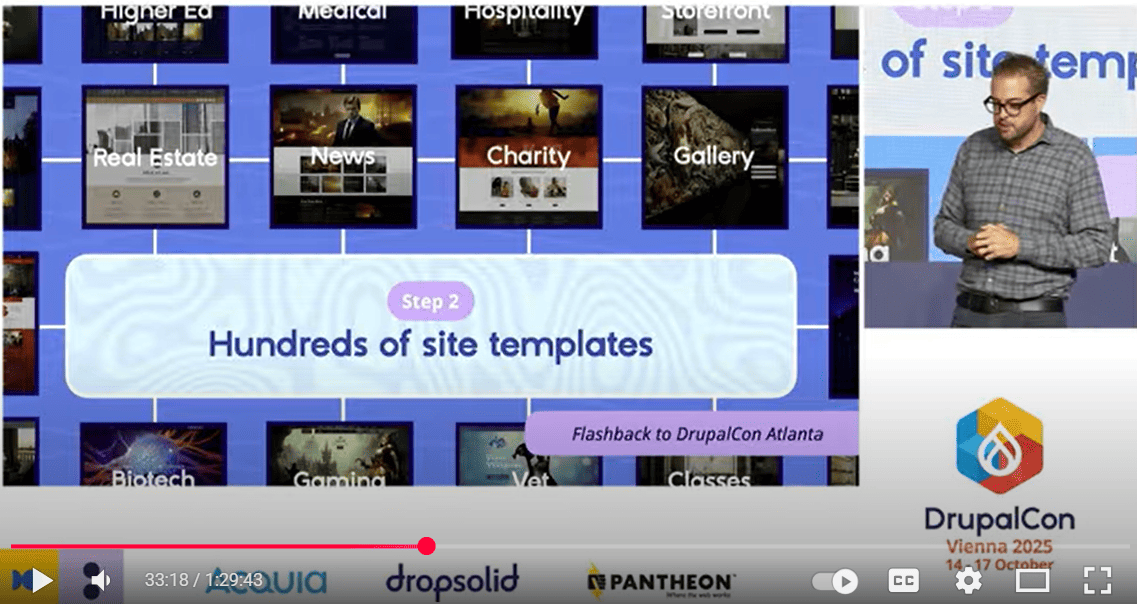
Marketplace: top templates in one place
The big question asked at the previous DrupalCon was whether we needed a marketplace for site templates. Tiffany Farris, Drupal Association Board Member and initiative lead, told the audience at Driesnote about the results of a survey. The community said yes, a marketplace is needed, but only if it delivers trustworthy and high-quality templates with transparent governance and open-source values at its core.
For a start, there will be a curated set of Drupal CMS templates, both free and paid, from a handful of certified partners, said Tiffany. Each will meet baseline standards for accessibility, security, documentation, and demo content.
Tim Lehnen, CTO of the Drupal Association, also said that there will be quality control with an automated and manual review system.
According to Dries, there should be 10 extra site templates soon, as part of the preparation for the Marketplace MVP. In the future, thousands of templates are expected. What is still needed is to open template creation to designers with no-code tools.
Drupal Canvas: a new way to build website pages
Drupal Canvas is the new name for what you might have heard of as Experience Builder. There was a trademark issue with that name, hence the rebranding.
Canvas enables site builders without Drupal experience to easily theme and build their entire website using only their browser. You begin with structured components like a hero banner, an image gallery, a testimonial block, or a product card. These predefined and reusable blocks make it easy to create consistent pages.
One of the greatest results of the hard work that has been done on Canvas is the integration of contributed modules. You can then format text in CKEditor, use the Metatag module to create a meta description and meta image, and use online forms like a contact form or others, thanks to the Webform module integration. Stay tuned for more details in our upcoming review of Drupal Canvas.
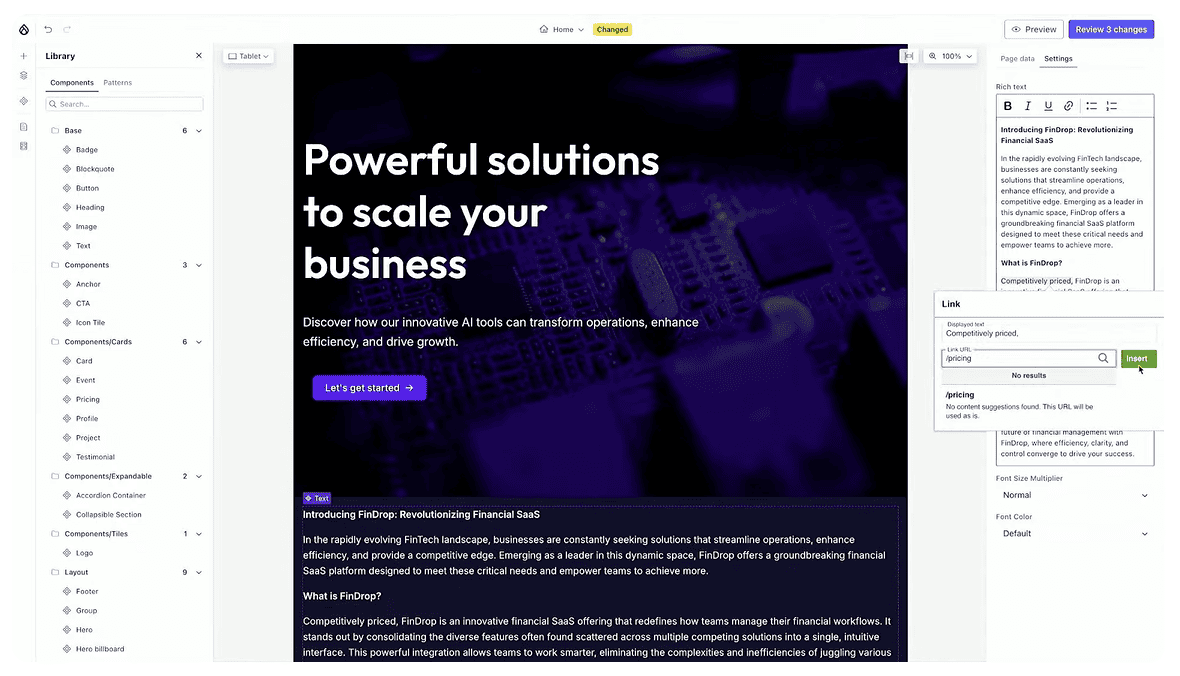
Content templates in Drupal Canvas
In addition to creating one-off landing pages, Canvas gives you control of the way your content types will be laid out for different view modes. Marketers will be able to tweak these layouts directly in the browser.
Adding blocks to Drupal Canvas using JavaScript
In the Driesnote demo, we also saw how Drupal Canvas enables developers to create components directly in the browser, relying on a couple of robust tools built into Canvas:
- JSON:API client
- SWR (stale-while-revalidate) — a React data-fetching library from Vercel
Once we are happy with the component, we can publish it and place it where intended.
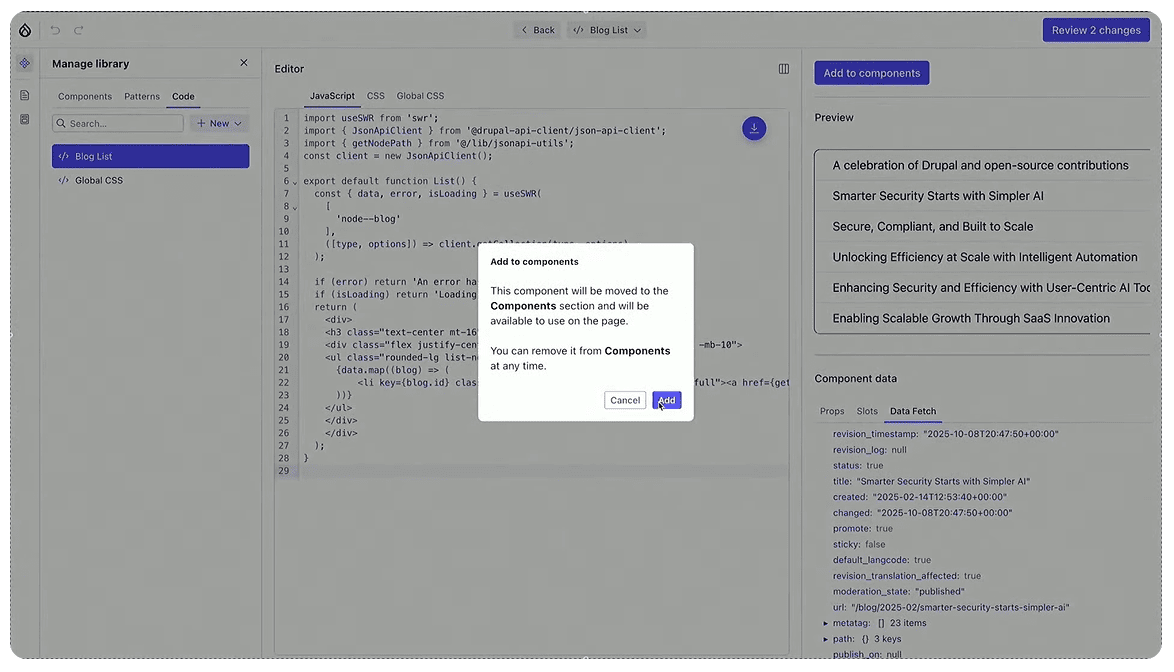
Autogenerating a Canvas component from Figma without coding
All developers know how difficult it is to go from a Figma design to a Drupal site. Next in the Driesnote Vienna, we see Drupal and Figma connected! The demo by Witze Van der Straeten showed how a pricing table component designed in Figma was automatically generated on a Drupal site without a single line of code. Witze used the Figma MCP server and a little help from Copilot, his AI Assistant in GitHub.
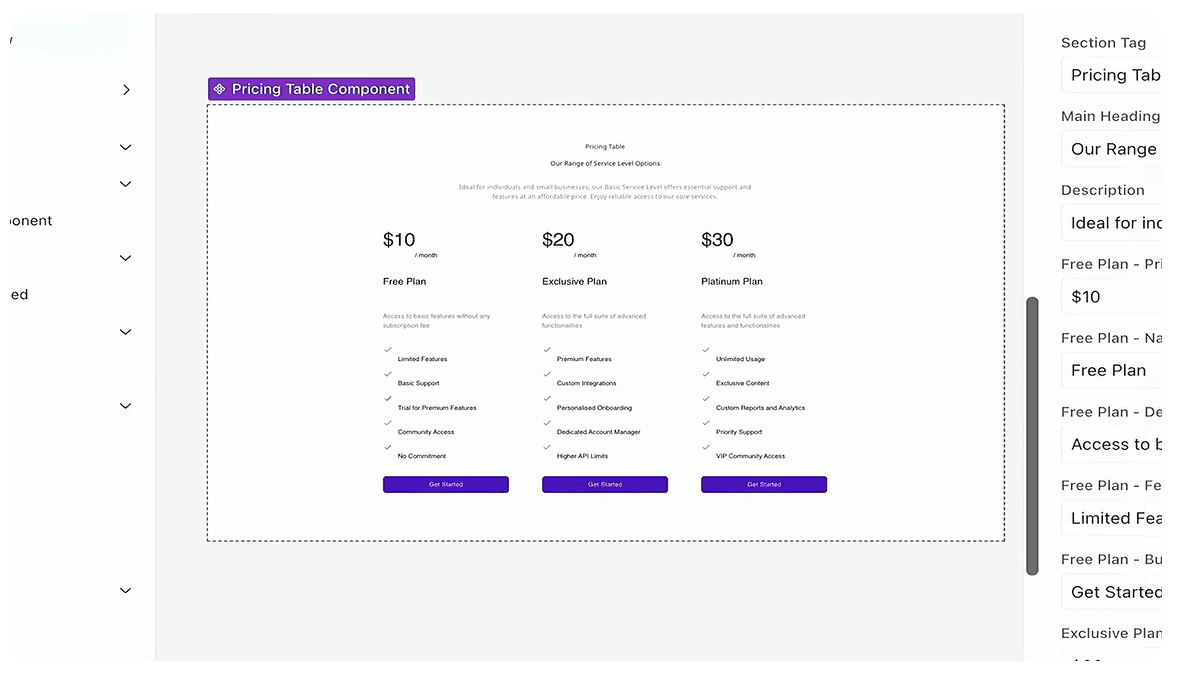
Magically creating a page with Drupal Canvas AI
What about seeing AI build an entire page on a Drupal website? A prompt was given to the Drupal Canvas AI for creating a landing page based on the LinkedIn ad that includes essential details about an upcoming event.
The Drupal Canvas AI plans the work and decides which agents should be involved. The agents use the prompt to decide which components are needed, generate content, and search for relevant images. The result is a fully-structured page that is ready to review, edit, and publish.
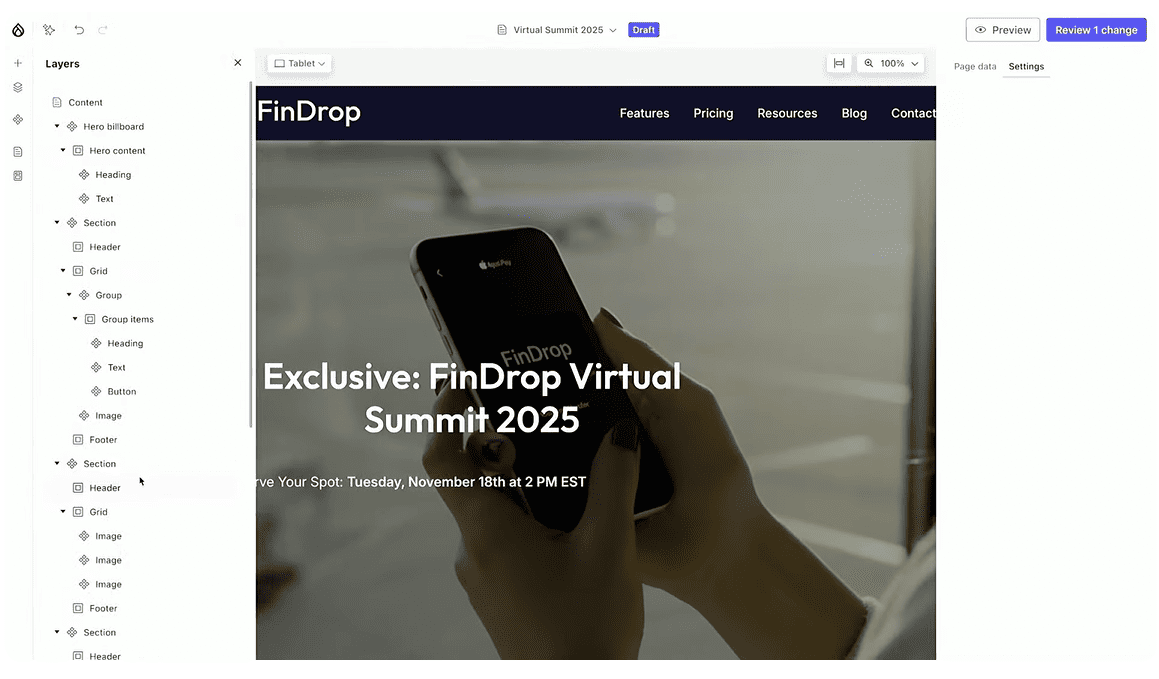
Context Control Center
To make sure every page captures the brand voice and the message you want to send to your users, you can rely on another new feature, Context Control Center. It’s a place where you can tell AI who you are, what you are targeting, key facts, the messages you want to emphasize, and so on.
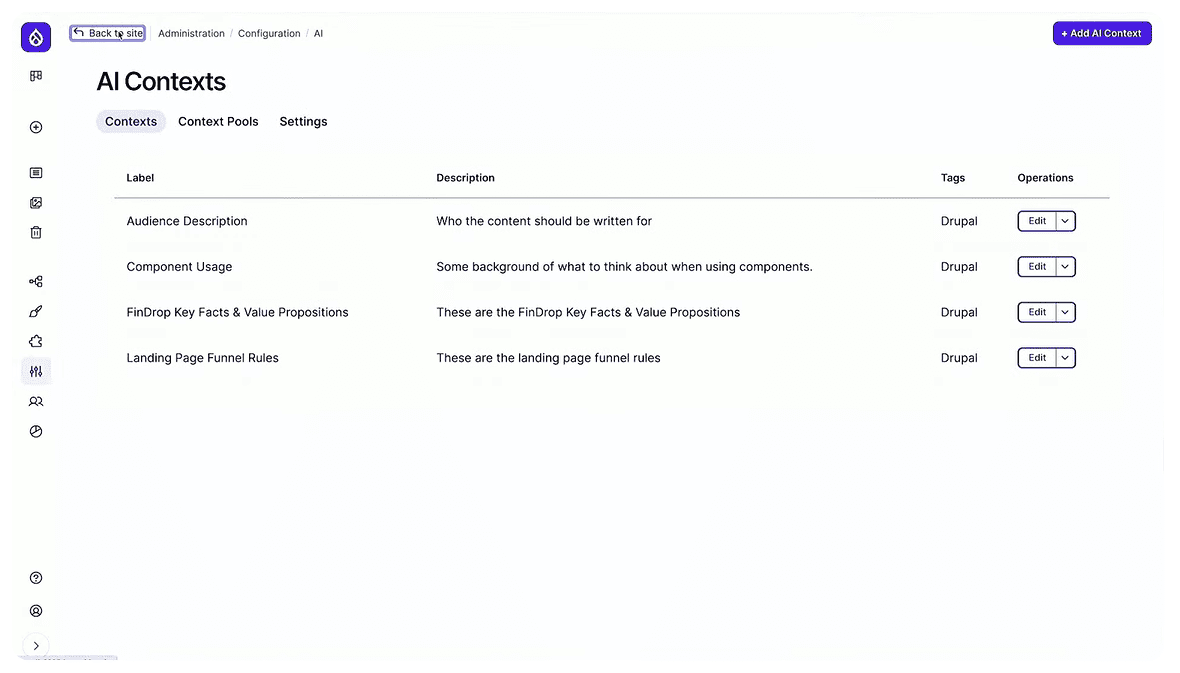
For example, you add the Audience Description context to the Context Control Center and ask AI to create a page with a “Who Should Attend” section. There’s no need to provide instructions about your target persona, Drupal AI knows it from the Context Control Center and will easily create the relevant section.
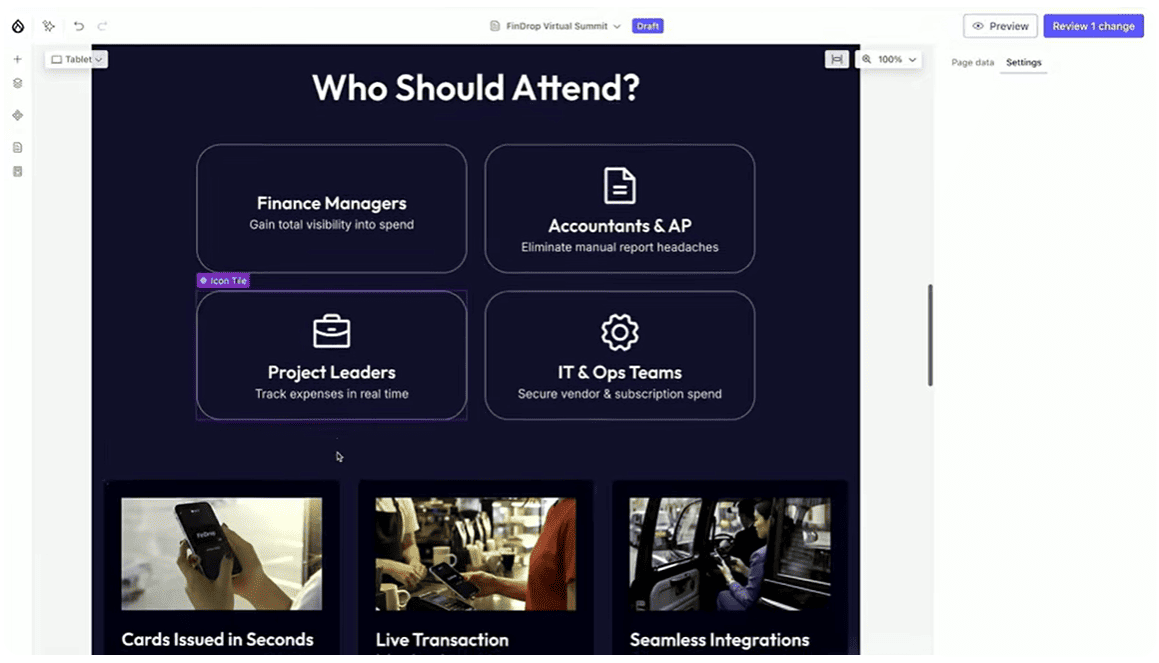
Autonomous Drupal agents
Autonomous Drupal agents that don’t wait for the prompt. Of course, with the right review process, and keep the human in the loop.
For example, you update the key facts and value proposition in the Context control center, and AI makes sure all the other content gets updated where the source context is used. After that, you’ll find an email in your inbox saying draft page updates are waiting.
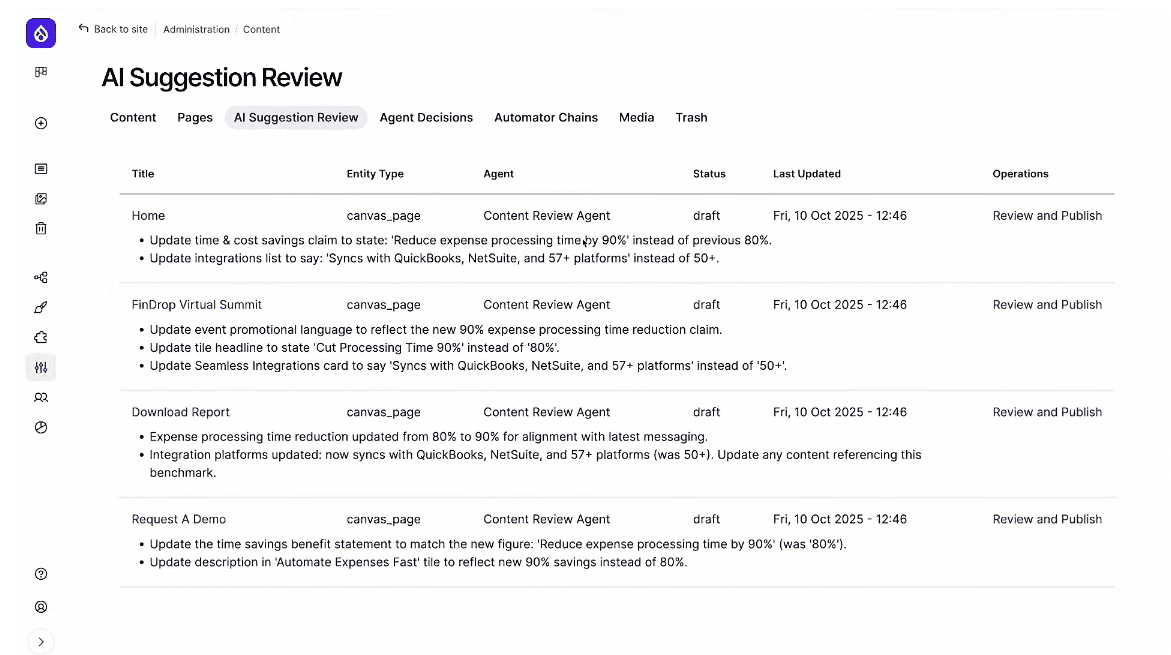
A roadmap for the new tools
Drupal Canvas 1.0 will be released in November. Soon after that, we should see Drupal CMS 2.0 with Canvas incorporated. This might happen in early January, to mark Drupal’s birthday.
“Canvas will ship with the default version of Drupal. It means that every new Drupal site that people start building will start by default with Canvas as the default experience. At least for me, this feels kind of like the start of a new era for Drupal.”
— Dries Buytaert
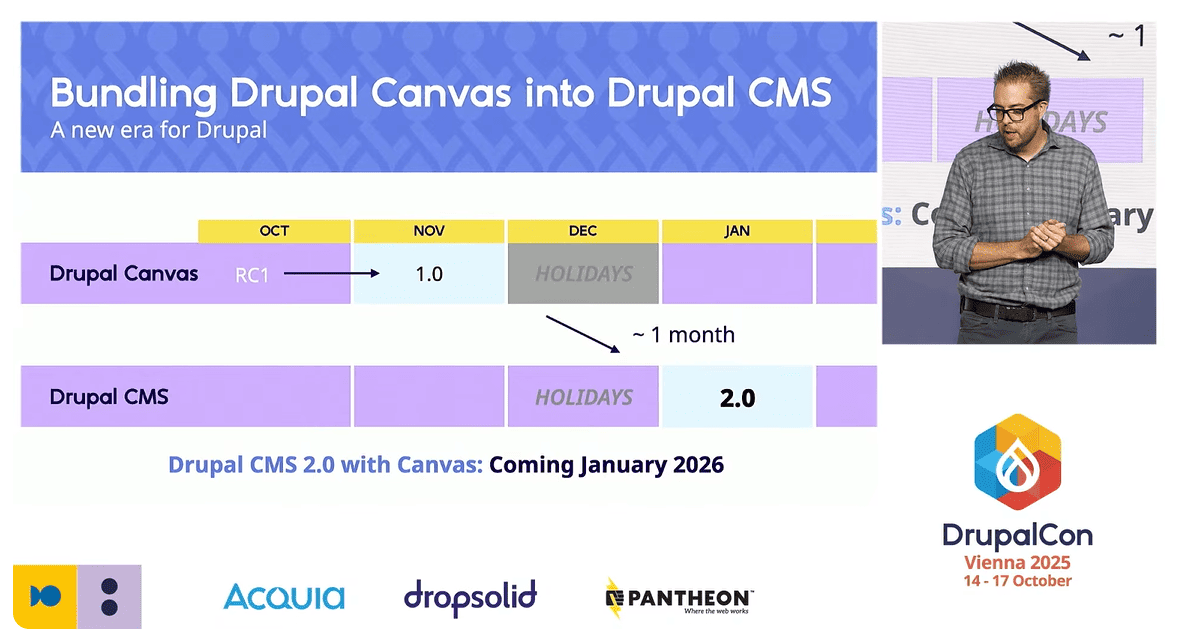
After the release of Drupal CMS 2.0 with Canvas, the Drupal CMS team is going to focus and double down on templates, Marketplace, and other things that have been shown in the Driesnote.
ECA: the famous website orchestration tool will get easier to use
The ECA module has generated huge buzz in the Drupal community because it helps create automatic Event-Condition-Action workflows. ECA is modern and robust, and equipped with a great graphical user interface that visualizes all workflows well. However, it comes with a learning curve. At Driesnote, we discovered that major improvements are underway that will make ECA more user-friendly. This was announced by the module’s creator, Jurgen Haas, following a productive conversation with Dries about ECA.
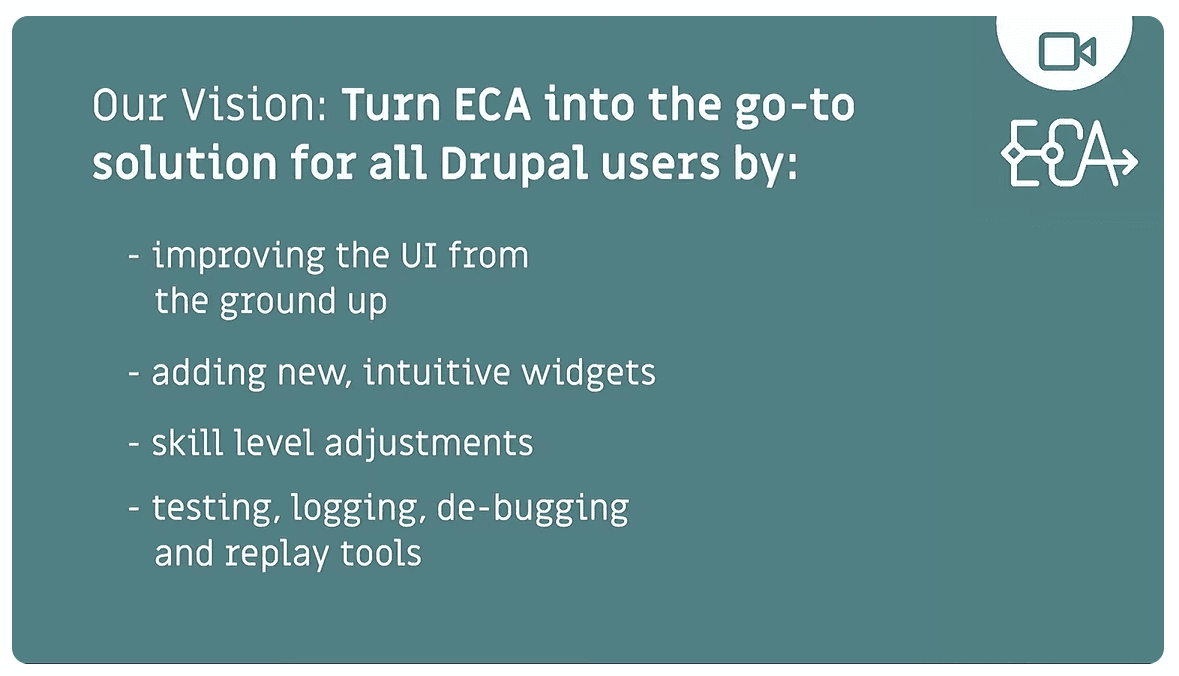
Introducing ActivePieces: a site orchestration tool with external integrations
Dries also told the audience about an external tool that had not been actively discussed in the Drupal community before, ActivePieces. It is an orchestration tool just like ECA, but more focused on external integrations than internal workflows.
Among the names for third-party services mentioned in the presentation were WooCommerce, Deep Seek, Discord, Discourse, Google Sheets, Sender, Productboards, TimelinesAI, and more. According to Dries, it also has the potential to transform how we work.
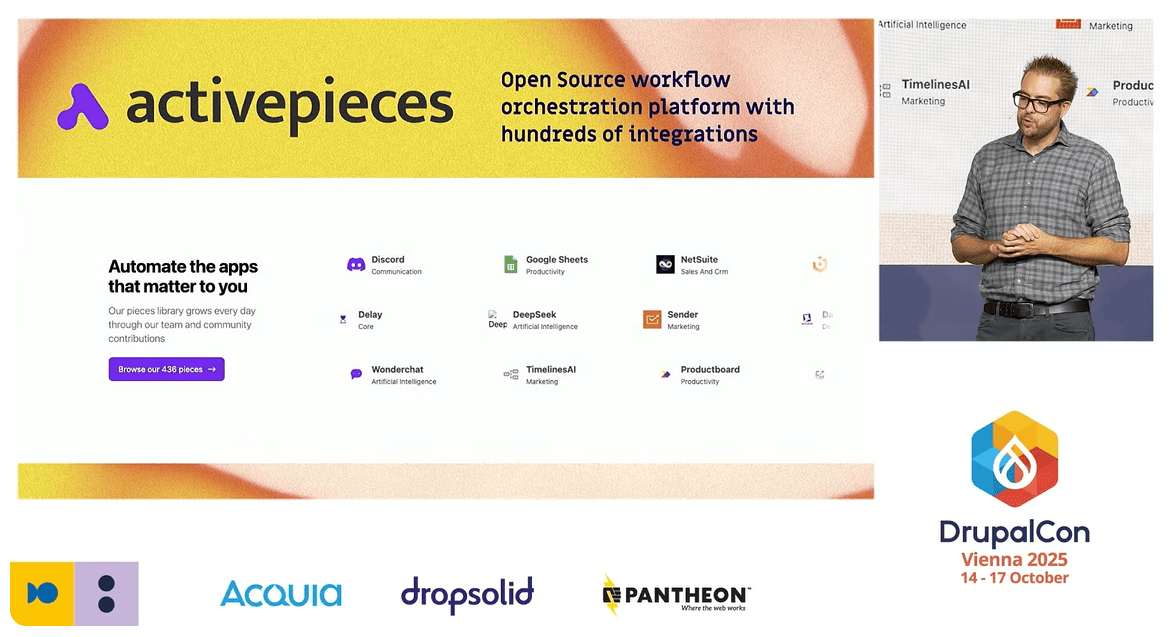
Dries showcased an elegant workflow powered by ActivePieces, designed to migrate content from a WordPress site to Drupal using a simple RSS feed as the bridge.
ActivePieces produced a clean JSON object with the imported content based on the feed. On the Drupal side, core modules such as Basic Auth and JSON:API provided the connection layer, enabling ActivePieces to authenticate, discover available content types and fields, and automatically map each element like title, body, and more.
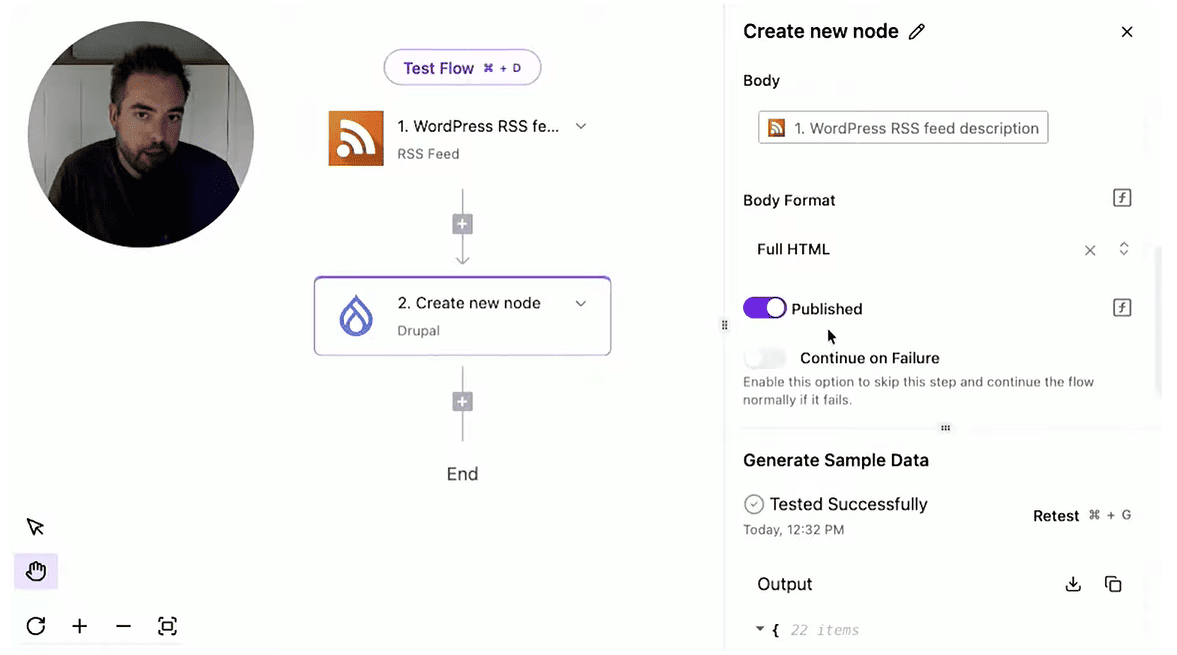
This was followed by a more complex demo involving ChatGPT that was asked to “druplify content”, turning words like “plugins” into “modules,” “widgets” into “blocks,” and make a few other tweaks. ChatGPT also analyzed the posts and decided which of them were relevant to Drupal users. If a post is relevant, it will be published to Drupal and logged into a Google Sheet. If not, it will be logged into the Google Sheet with the “needs review” status.
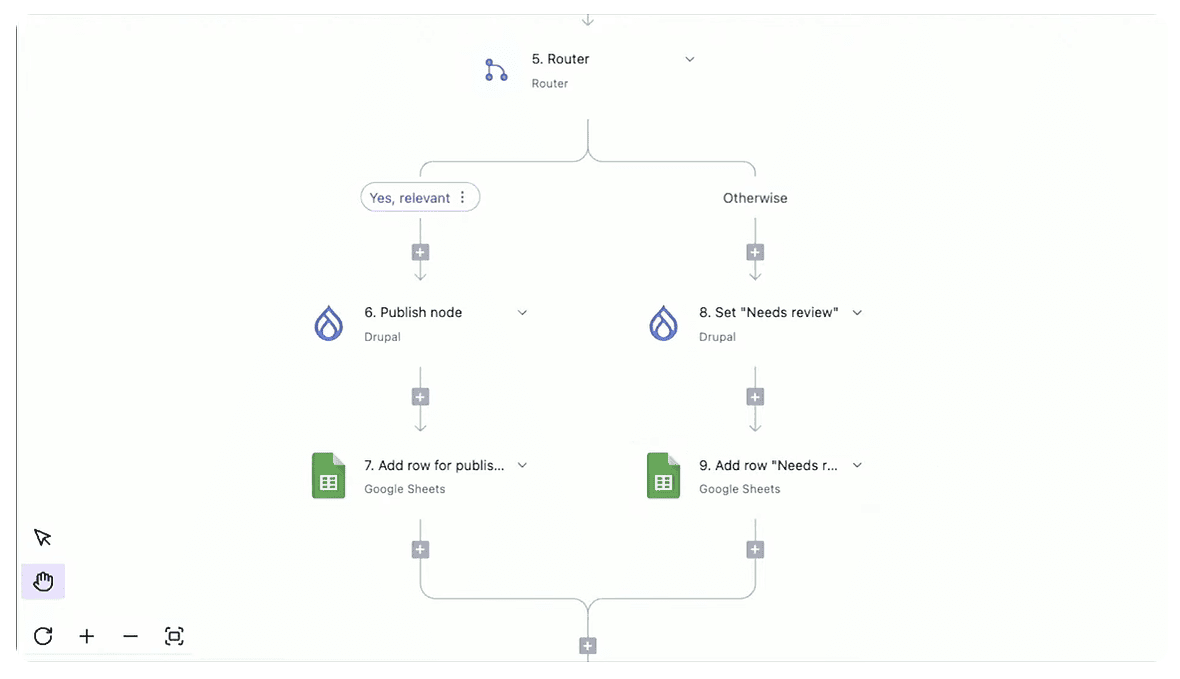
Furthermore, there can even be a flow where changes in the Google Sheet are automatically put into action. For example, when someone marks an item as approved, it gets published. Even more, when there is a “needs review” item in the Sheet, it will trigger an ECA workflow together with the Content Moderation and Workflow modules, making sure editors can review the pieces.
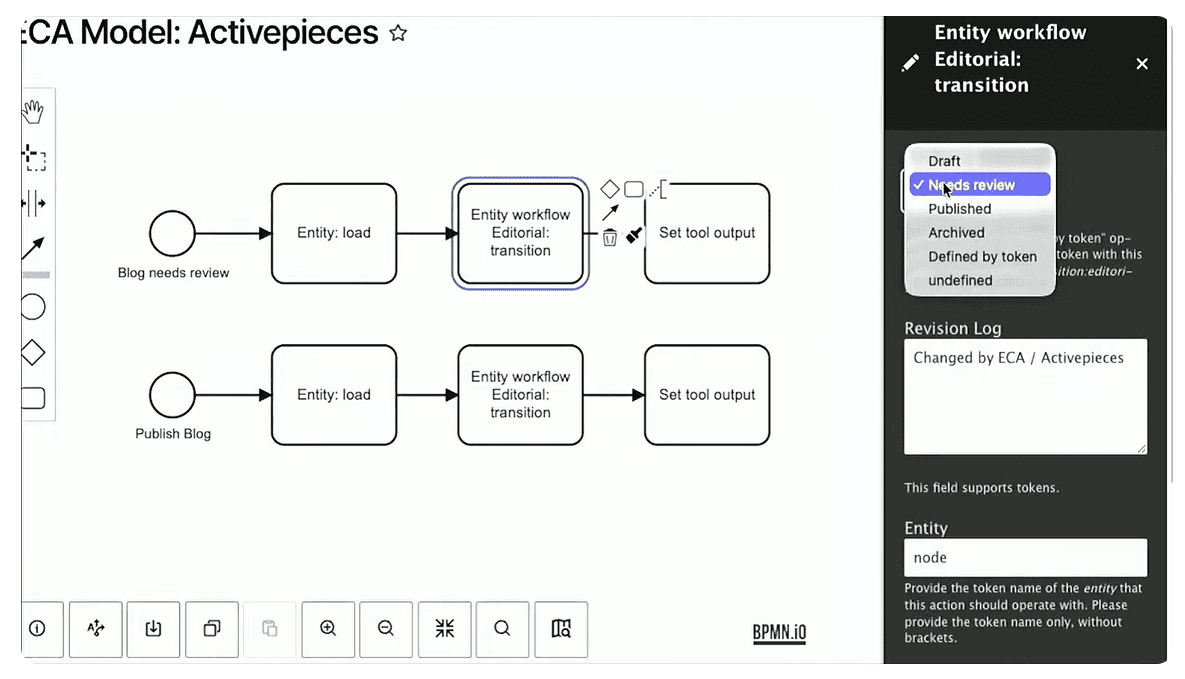
The new Orchestration module in Drupal
The above setups are a great example of how internal and external orchestration tools can work together, transforming digital experiences. Dries is very excited about it, and he announced the new Orchestration module for Drupal. He encouraged everyone to get involved by testing the module, integrating more automation tools, adding workflows to ECA, and so on.
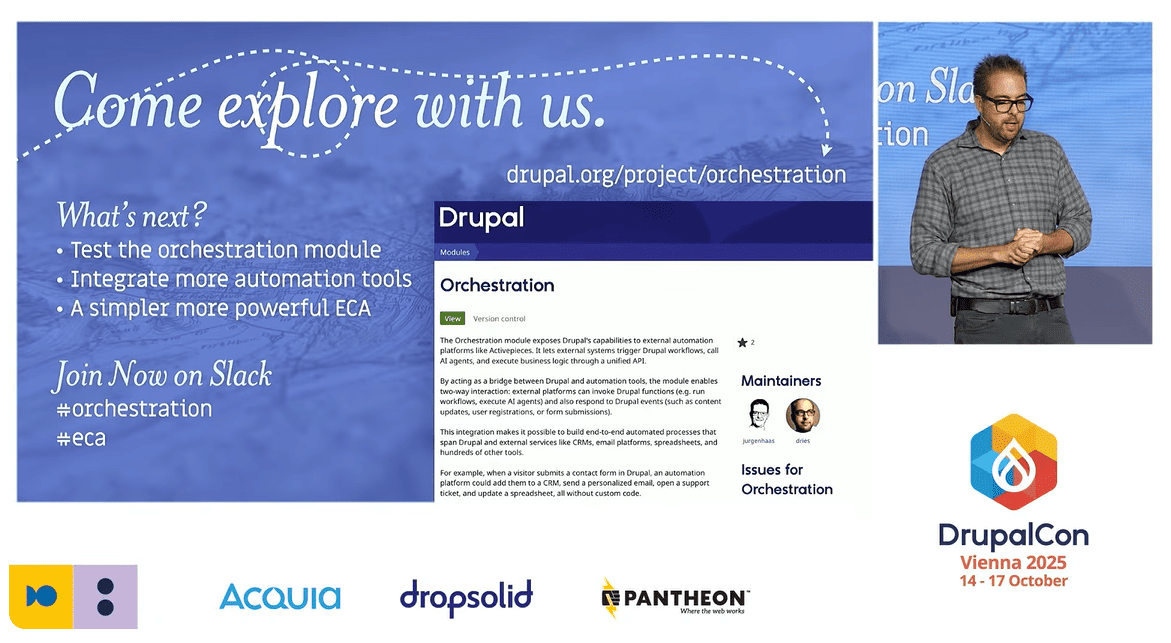
Final thoughts
Even though AI is transforming the way users interact with content, reducing clicks to websites, we will still need good websites because that’s where trust, ownership, and identity live, said Dries. It’s the one place where you can fully own and express yourself in your own words, your own design, your own brand, he added.
Yes, the future is a little uncertain, and there’s plenty of uncharted territory ahead, Dries acknowledged. But he emphasized that Drupal already has an incredible head start with features competitors don’t yet have, along with a strong moral compass that will guide the community to do things the right way.
We’re fully sharing Drupal’s founder’s optimism about the future of the Open Web, a future with high-quality content, fewer ads, and better user experiences. And we’re excited to be part of creating it!
